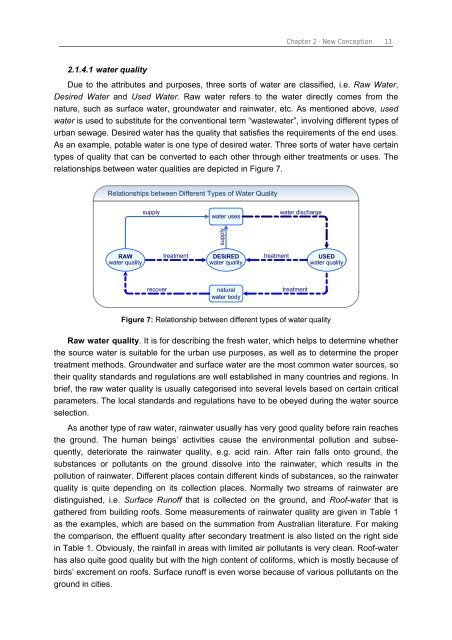Chapter 3 Decision Support Model (IUWS-DSM) - Tubdok
Chapter 3 Decision Support Model (IUWS-DSM) - Tubdok
Chapter 3 Decision Support Model (IUWS-DSM) - Tubdok
You also want an ePaper? Increase the reach of your titles
YUMPU automatically turns print PDFs into web optimized ePapers that Google loves.
2.1.4.1 water quality<br />
<strong>Chapter</strong> 2 · New Conception 13<br />
Due to the attributes and purposes, three sorts of water are classified, i.e. Raw Water,<br />
Desired Water and Used Water. Raw water refers to the water directly comes from the<br />
nature, such as surface water, groundwater and rainwater, etc. As mentioned above, used<br />
water is used to substitute for the conventional term “wastewater”, involving different types of<br />
urban sewage. Desired water has the quality that satisfies the requirements of the end uses.<br />
As an example, potable water is one type of desired water. Three sorts of water have certain<br />
types of quality that can be converted to each other through either treatments or uses. The<br />
relationships between water qualities are depicted in Figure 7.<br />
Relationships between Different Types of Water Quality<br />
RAW<br />
water quality<br />
supply water discharge<br />
water uses<br />
recover<br />
treatment<br />
supply<br />
DESIRED<br />
water quality<br />
natural<br />
water body<br />
treatment<br />
treatment<br />
USED<br />
water quality<br />
Figure 7: Relationship between different types of water quality<br />
Raw water quality. It is for describing the fresh water, which helps to determine whether<br />
the source water is suitable for the urban use purposes, as well as to determine the proper<br />
treatment methods. Groundwater and surface water are the most common water sources, so<br />
their quality standards and regulations are well established in many countries and regions. In<br />
brief, the raw water quality is usually categorised into several levels based on certain critical<br />
parameters. The local standards and regulations have to be obeyed during the water source<br />
selection.<br />
As another type of raw water, rainwater usually has very good quality before rain reaches<br />
the ground. The human beings’ activities cause the environmental pollution and subsequently,<br />
deteriorate the rainwater quality, e.g. acid rain. After rain falls onto ground, the<br />
substances or pollutants on the ground dissolve into the rainwater, which results in the<br />
pollution of rainwater. Different places contain different kinds of substances, so the rainwater<br />
quality is quite depending on its collection places. Normally two streams of rainwater are<br />
distinguished, i.e. Surface Runoff that is collected on the ground, and Roof-water that is<br />
gathered from building roofs. Some measurements of rainwater quality are given in Table 1<br />
as the examples, which are based on the summation from Australian literature. For making<br />
the comparison, the effluent quality after secondary treatment is also listed on the right side<br />
in Table 1. Obviously, the rainfall in areas with limited air pollutants is very clean. Roof-water<br />
has also quite good quality but with the high content of coliforms, which is mostly because of<br />
birds’ excrement on roofs. Surface runoff is even worse because of various pollutants on the<br />
ground in cities.

















